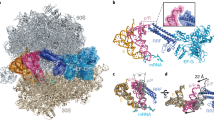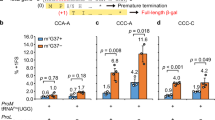Abstract
The L shape of tRNA is stabilized by the 'tertiary core' region, which contains base-pairing interactions between the D and T loops. Distortions of the L shape accompany tRNA movement across the ribosomal surface. Here, using single-turnover rapid kinetics assays, we determine the effects of mutations within the tertiary core of P site–bound tRNAfMet on three measures of the rate of translocation, the part of the elongation cycle involving the most extensive tRNA movement. Mutations in the strictly conserved G18·U55 base pair result in as much as an 80-fold decrease in the rate of translocation, demonstrating the importance of the 18-55 interaction for rapid translocation. This implicates the core region as a locus for functionally important dynamic interactions with the ribosome and leads to the proposal that translocation of ribosome-bound tRNAs may be sequential rather than concerted.
This is a preview of subscription content, access via your institution
Access options
Subscribe to this journal
Receive 12 print issues and online access
$189.00 per year
only $15.75 per issue
Buy this article
- Purchase on Springer Link
- Instant access to full article PDF
Prices may be subject to local taxes which are calculated during checkout




Similar content being viewed by others
References
Robertus, J.D. et al. Structure of yeast phenylalanine tRNA at 3 Å resolution. Nature 250, 546–551 (1974).
Kim, S.H. et al. Three-dimensional tertiary structure of yeast phenylalanine transfer RNA. Science 185, 435–440 (1974).
Zagryadskaya, E.I., Kotlova, N. & Steinberg, S.V. Key elements in maintenance of the tRNA L-shape. J. Mol. Biol. 340, 435–444 (2004).
Davanloo, P., Sprinzl, M., Watanabe, K., Albani, M. & Kersten, H. Role of ribothymidine in the thermal stability of transfer RNA as monitored by proton magnetic resonance. Nucleic Acids Res. 6, 1571–1581 (1979).
Sampson, J.R. & Uhlenbeck, O.C. Biochemical and physical characterization of an unmodified yeast phenylalanine transfer RNA transcribed in vitro. Proc. Natl. Acad. Sci. USA 85, 1033–1037 (1988).
Nobles, K.N., Yarian, C.S., Liu, G., Guenther, R.H. & Agris, R.F. Highly conserved modified nucleosides influence Mg2+-dependent tRNA folding. Nucleic Acids Res. 30, 4751–4760 (2002).
Frank, J. et al. The role of tRNA as a molecular spring in decoding, accommodation, and peptidyl transfer. FEBS Lett. 579, 959–962 (2005).
Yusupov, M.M. et al. Crystal structure of the ribosome at 5.5 Å resolution. Science 292, 883–896 (2001).
Nekhai, S.A., Parfenov, D.V. & Saminsky, E.M. tRNA regions which contact with the ribosomal poly(U)-programmed P-site. Biochim. Biophys. Acta 1218, 481–484 (1994).
Herr, A.J., Atkins, J.F. & Gesteland, R.F. Mutations which alter the elbow region of tRNA2Gly reduce T4 gene 60 translational bypassing efficiency. EMBO J. 18, 2886–2896 (1999).
Rodnina, M.V., Savelsbergh, A., Katunin, V.I. & Wintermeyer, W. Hydrolysis of GTP by elongation factor G drives tRNA movement on the ribosome. Nature 385, 37–41 (1997).
Katunin, V.I., Savelsbergh, A., Rodnina, M.V. & Wintermeyer, W. Coupling of GTP hydrolysis by elongation factor G to translocation and factor recycling on the ribosome. Biochemistry 41, 12806–12812 (2002).
Savelsbergh, A. et al. An elongation factor G-induced ribosome rearrangement precedes tRNA-mRNA translocation. Mol. Cell 11, 1517–1523 (2003).
Katunin, V.I., Muth, G.W., Strobel, S.A., Wintermeyer, W. & Rodnina, M.V. Important contribution to catalysis of peptide bond formation by a single ionzing group within the ribosome. Mol. Cell 10, 339–346 (2002).
Doyon, F.R., Zagryadskaya, E.I., Chen, J. & Steinberg, S.V. Specific and non-specific purine trap in the T-loop of normal and suppressor tRNAs. J. Mol. Biol. 343, 55–69 (2004).
de Smit, M.H. et al. Structural variation and functional importance of a D-loop-T-loop interaction in valine-accepting tRNA-like structures of plant viral RNAs. Nucleic Acids Res. 30, 4232–4240 (2002).
Peterson, E.T., Blank, J., Sprinzl, M. & Uhlenbeck, O.C. Selection for active E. coli tRNA(Phe) variants from a randomized library using two proteins. EMBO J. 12, 2959–2967 (1993).
Peske, F., Savelsbergh, A., Katunin, V.I., Rodnina, M.V. & Wintermeyer, W. Conformational changes of the small ribosomal subunit during elongation factor G-dependent tRNA-mRNA translocation. J. Mol. Biol. 343, 1183–1194 (2004).
Seo, H.S. et al. EF-G-dependent GTPase on the ribosome. Conformational change and fusidic acid inhibition. Biochemistry, published online 1 February 2006 (10.1021/bi0516677).
Valle, M. et al. Locking and unlocking of ribosomal motions. Cell 114, 123–134 (2003).
Lill, R., Robertson, J.M. & Wintermeyer, W. Binding of the 3′ terminus of tRNA to 23S rRNA in the ribosomal exit site actively promotes translocation. EMBO J. 8, 3933–3938 (1989).
Feinberg, J.S. & Joseph, S. Identification of molecular interactions between P-site tRNA and the ribosome essential for translocation. Proc. Natl. Acad. Sci. USA 98, 11120–11125 (2001).
Du, X. & Wang, E.D. Tertiary structure base pairs between D- and TpsiC-loops of Escherichia coli tRNA(Leu) play important roles in both aminoacylation and editing. Nucleic Acids Res. 31, 2865–2872 (2003).
Sampson, J.R., DiRenzo, A.B., Behlen, S.L. & Uhlenbeck, O.C. Role of the tertiary nucleotides in the interaction of yeast phenylalanine tRNA with its cognate synthetase. Biochemistry 29, 2523–2532 (1990).
Noller, H.F., Yusupov, M.M., Yusupova, G.Z., Baucom, A. & Cate, J.H. Translocation of tRNA during protein synthesis. FEBS Lett. 514, 11–16 (2002).
Cochella, L. & Green, R. An active role for tRNA in decoding beyond codon-anticodon pairing. Science 308, 1178–1180 (2005).
Rodnina, M.V. & Wintermeyer, W. GTP consumption of elongation factor Tu during translation of heteropolymeric mRNAs. Proc. Natl. Acad. Sci. USA 92, 1945–1949 (1995).
Rodnina, M.V., Semenkov, Y.P. & Wintermeyer, W. Purification of fMet-tRNA(fMet) by fast protein liquid chromatography. Anal. Biochem. 219, 380–381 (1994).
Semenkov, Y., Makarov, E. & Kivillov, S. Quantitative study of interaction of deacylated tRNA with the P, A and E sites of Escherichia coli ribosomes. Biopolym. Cell 1, 183–193 (1985).
Wintermeyer, W. & Zachau, H.G. Replacement of odd bases in tRNA by fluorescent dyes. Methods Enzymol. 29, 667–673 (1974).
Hou, Y.M., Westhof, E. & Giege, R. An unusual RNA tertiary interaction has a role for the specific aminoacylation of a transfer RNA. Proc. Natl. Acad. Sci. USA 90, 6776–6780 (1993).
Ramamurthy, V., Swann, S.L., Paulson, J.L., Spedaliere, C.J. & Mueller, E.G. Critical aspartic acid residues in pseudouridine synthases. J. Biol. Chem. 274, 22225–22230 (1999).
Bradford, M.M. A rapid and sensitive method for the quantitiation of microgram quantities of protein utilizing the principle of protein-dye binding. Anal. Biochem. 72, 248–254 (1976).
Brune, M., Hunter, J.L., Corrie, J.E. & Webb, M.R. Direct, real-time measurement of rapid inorganic phosphate release using a novel fluorescent probe and its application to actomyosin subfragment 1 ATPase. Biochemistry 33, 8262–8271 (1994).
Wahler, B.E. & Wollenberger, A. Determination of orthophosphate in the presence of phosphate compounds with an affinity for acids and molybdate. Biochem. Z. 329, 508–520 (1958).
Bocchetta, M., Xiong, L., Shah, S. & Mankin, A.S. Interactions between 23S rRNA and tRNA in the ribosomal E site. RNA 7, 54–63 (2001).
Semenkov, Y.P., Rodnina, M.V. & Wintermeyer, W. Energetic contribution of tRNA hybrid state formation to translocation catalysis on the ribosome. Nat. Struct. Biol. 7, 1027–1031 (2000).
Acknowledgements
This work was supported by US National Institutes of Health grants to B.S.C. (GM071014) and Y.M.H. (GM56662). C.M.Z. is supported by a postdoctoral fellowship from the American Heart Association, Pennsylvania-Delaware Affiliate.
Author information
Authors and Affiliations
Corresponding author
Ethics declarations
Competing interests
The authors declare no competing financial interests.
Rights and permissions
About this article
Cite this article
Pan, D., Kirillov, S., Zhang, CM. et al. Rapid ribosomal translocation depends on the conserved 18-55 base pair in P-site transfer RNA. Nat Struct Mol Biol 13, 354–359 (2006). https://doi.org/10.1038/nsmb1074
Received:
Accepted:
Published:
Issue Date:
DOI: https://doi.org/10.1038/nsmb1074
This article is cited by
-
Human mitochondria require mtRF1 for translation termination at non-canonical stop codons
Nature Communications (2023)
-
Maintenance of protein synthesis reading frame by EF-P and m1G37-tRNA
Nature Communications (2015)
-
Structure of EF-G–ribosome complex in a pretranslocation state
Nature Structural & Molecular Biology (2013)
-
Energy barriers and driving forces in tRNA translocation through the ribosome
Nature Structural & Molecular Biology (2013)



